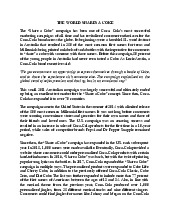

Preview text:
lOMoARcPSD|364 906 32
Push and Pull Strategies in Mobile Marketing
Mobile marketing strategies can be viewed similarly to those on the Internet—that is, driving
information to consumers (push strategies) and driving consumers to information (pull strategies).
Mobile Push. Driving information to consumers on mobile devices can involve a variety of
strategies. One strategy that will continue to grow as more consumers use mobile Internet is ads
placed on mobile web pages. As with computer-based approaches, mobile ads can be targeted
to be most relevant to the specific mobile content being viewed. Another strategy is
permissionbased or opt-in text messaging promotions. According to a media consulting group,
the best text message programs involve -
Building an “opt-in” database—this can be done through traditional and e-mail
marketing in which consumers are asked to text in or register at a specific website. -
Developing the text-message “ad”—this should include (a) a hook relating to why the
individual is being contacted; (b) a call to action, such as entering a code to get a discount; and (c) an “opt-out” option. -
Rolling out the campaign—this involves delivering the text promotion to those on the opt-in list.
Adidas used a variation of this approach as sponsor for the NBA All-Star week. It had game
information, store events, athlete appearances, and shoe releases as part of its promotions.
Consumers opted in and then could access all the promotional materials at any time during the
week by texting “originals.”
Mobile Pull. Driving consumers to information on mobile devices also can involve a number of
strategies. One is to use traditional media to build awareness about a mobile site or promotional
event. AT&T held a mobile contest on U.S. college campuses for a free Dave Matthews Band
concert to the school that could generate the most “invitations” sent through text messaging for
the band to play at their school. To generate awareness and drive students to its mobile space,
AT&T blanketed college campuses with posters telling students to “Text DMB to 959” or “visit
ATTBLUEROOM.COM to enter.” As we have seen, mobile search is another important option.
Mobile Internet use is increasing rapidly and the functionality and geo-targeting capabilities of
providers such as Google and Yahoo allow marketers to drive traffic not only to traditional
websites and mobile content, but also to local restaurants and retailers. lOMoARcPSD|364 906 32
**Critical Thinking Questions** 1.
With cell or smartphones even less easily controlled and monitored than home
computers, what ethical and regulatory issues are raised regarding mobile marketing to children? 2.
Beyond the approaches discussed above, what other mobile marketing approaches are
emerging? Are they effective? Explain. 3.
What challenges do marketers face as they have to create campaigns that span mobile,
Internet, and traditional media? ---
Document Outline
- Push and Pull Strategies in Mobile Marketing




